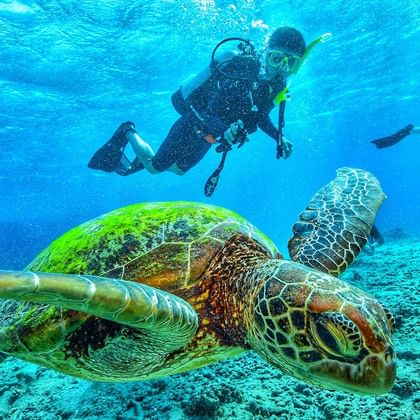Diving Certificate opens to a world of amazing experiences and can be used anywhere in the world. Here you can read our guide on Diving Certificate.
Bering Travel's guide to diving certificate



Diving Certificate opens to a world of amazing experiences and can be used anywhere in the world. Here you can read our guide on Diving Certificate.

If you are considering getting a diving certificate, you can use this guide to get an overview of the different options. In this guide, we review the three largest dive systems and what the differences are on them, but you should know that on our travels we use only PADI centers.
Once you have taken your diving certificate, you are trained to dive to a depth of 18 meters anywhere in the world.
It is important that you are aware that the diving certificate is in itself just the entrance to the world under the sea and you are learning the basic skills. Then comes the real learning, where it comes to getting a lot of dives and through that a lot of training.
A dive course typically takes 3-5 days and once it's over, you can start exploring the great world under the sea - and the best part is that you can use your diving certificate anywhere in the world and it's a great way to get a lots of unforgettable experiences. For example, you can rent diving equipment from diving centers around the world and participate in diving trips. Most newly hatched divers go on diving vacations, where they can get new experiences and get more dives in the logbook and those who want to take the dive a little more seriously take on liveaboards.
Liveaboards are diving trips where you stay on a boat for a period of time and dive 3-4 times a day during the trip. It is the safe route to great diving experiences.
PADI (Professional Association of Diving Instructors)
Founded in the United States in 1966, PADI is the largest and most recognized diving certification agency in the world. PADI has more than 137,000 affiliated dive instructors and 6,600 dive centers and resorts. In other words, you will find PADI centers all over the world.
At Bering Rejser we only use PADI centers and all employees are PADI divers.
Read about PADI's story here
SSI (Scuba School International)
SSI is the world's second most popular diving certification agency and was also founded in the United States in 1970. SSI has more than 2,800 affiliated dive centers worldwide.
Read more about SSI's history here
CMAS (World Confederation of Underwater Activities)
CMAS is the umbrella organization for diving organizations. CMAS has more than 130 diving associations.
An important difference between CMAS and the other courses is that it takes significantly longer to complete the course. Where PADI and SSI typically take 3-5 days, CMAS will take several months to complete.
Read about CMAS here
Since we are exclusively burger PADI centers on our travels, we will just describe what is included in a PADI course. It is also the most widely used in the world and therefore you will generally find it easiest to find PADI courses when traveling.
The PADI Open Water Diver consists of three elements:
Theory - (5 modules and exam) This part can be done both from home with an E-learning course (always costs extra) or you can be taught locally based on the PADI manual. We recommend the E-learning course as it is very educational and it is great to be able to pass all the theory away from home so you can spend the holidays on the fun - diving.
Confined Water - (5 modules eg in a pool) Here you will learn the very basic skills that you will need when diving. In some places, the Confined Water part is also arranged in the sea, but in safe places.
Open Water - (4 dives in the sea) Now the fun starts and you get your first real dive in the sea.
When we write that a PADI course can be completed in 3-5 days, it depends on how intense you want to do it. The normal thing is that it takes five days to complete a PADI Open Water Course.
2 days of theory (unless you made this from home)
1 day Confined Water
2 days of Open Water dive (2 dives per day)
A video from PADI describing the Open Water Course
If you think it's boring to do theory and confined water dives on your vacation, then you can take the Open Water Diver Referral, where you take Theory and Confined Water from home and then complete the course with the Open Water dives on your trip.
Contact us if you want to know more about this opportunity.
